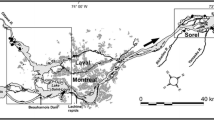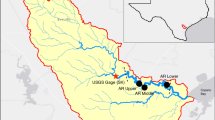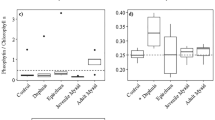Abstract
Differences in phytoplankton community composition along a riverine to, freshwater tidal continuum was an important factor affecting the primary productivity and quantity of phytoplankton biomass available to the San Francisco Estuary food web downstream. The relative contribution of riverine and freshwater tidal phytoplankton was determined using measurements of primary productivity, respiration, and phytoplankton species composition along a riverine to freshwater tidal gradient in the San Joaquin River, one of two major rivers that flow into, the San Francisco Estuary. Chla-specific net primary productivity was greater in the freshwater tidal habitat and was correlated with both a higher growth efficiency and maximum growth potential compared with the river upstream. Cluster analysis indicated these differences in growth parameters were associated with differences in species composition, with greater percent diatom and green algal species biomass upstream and flagellate biomass downstream. Correlation between the chla specific net productivity and phytoplankton species composition suggested the downstream shift from riverine diatom and green algal species to flagellate species contributed to the seaward increase in net primary productivity. Environmental conditions, such as specific conductance and water transparency, may have influenced primary productivity along the riverine to freshwater tidal continuum through their effect on both species composition and growth rate. Data suggest light was not the sole controlling factor for primary productivity in this highly turbid estuary; phytoplankton growth rate did not increase when riverine plankton communities from low light conditions upstream were exposed to higher light conditions downstream. This study suggests that the availability of phytoplankton biomass to the estuarine food web may be influenced by management of both phytoplankton growth and community composition along the riverine to freshwater tidal continuum.
Similar content being viewed by others
Literature Cited
American Public Health Association (APHA), American Water Works Association and Water Environment Association. 1998. Standard Methods for the Examination of Water and Wastewater, 20th edition. APHA, Washington, D.C.
Basu, B. K. andF. R. Pick. 1996. Factors regulating phytoplankton and zooplankton biomass in temperate rivers.Limnology and Oceanography 41:1572–1577.
Brion, N., G. Billeb, L. Guezennec, andA. Fight. 2000. Distribution of nitrifying activity in the Seine River (France) from Paris to the estuary.Estuaries 23:669–682.
Caraco, N. F., J. J. Cole, P. A. Raymond, D. L. Strayer, M. L. Pace, S. E. Findlay, andD. T. Fischer. 1997. Zebra mussel invasion in a large, turbid river: Phytoplankton response to increased grazing.Ecology 78:588–602.
Cole, J. J., N. F. Caraco, andB. L. Peierls. 1992. Can phytoplankton maintain a positive carbon balance in a turbid, freshwater, tidal estuary?Limnology and Oceanography 37:1608–1617.
De Ruyter van Steveninck, E. D., W. Admiraal, L. Breebaart, G. M. J. Tubbing, andB. van Zanten. 1992. Plankton in the River Rhine: Structural and functional changes observed during downstream transport.Journal of Plankton Research 14:1351–1368.
Garnier, J., G. Billen, andM. Coste. 1995. Seasonal succession of diatoms and Chlorophyceae I the drainage network of the Seine River: Observations and modeling.Limnology and Oceanography 40:750–765.
Heip, C. H. R., N. K. Goosen, P. M. J. Herman, J. Kromkamp, J. J. Middelburg, andK. Soetaert. 1995. Production and consumption of biological particles in temperate tidal estuaries.Oceanography and Marine Biology: An Annual Review 33:1–149.
Hynes, H. B. N. 1970. The Ecology of Running Waters. University of Toronto Press, Toronto, Canada.
Izaguirre, I., I. O'Farrell, andG. Tell. 2001. Variation in phytoplankton composition and limnological features in a water-water ecotone of the Lower Paraná Basin (Argentina).Freshwater Biology 46:63–74.
Jassby, A. D. 2005. Phytoplankton regulation in a eutrophic tidal river (San Joaquin River, California).San Francisco Estuary and Watershed Science 3:1–22.
Jassby, A. D., J. E. Cloern, andB. E. Cole. 2002. Annual primary production: Patterns and mechanisms of change in a nutrientrich tidal ecosystem.Limnology and Oceanography 47:698–712.
Jassby, A. D., W. J. Kimmerer, S. G. Monismith, C. Armor, J. E. Cloern, T. M. Powell, J. R. Schubel, andT. J. Vendlinski. 1995. Isohaline position as a habitat indicator for estuarine populations.Ecological Applications 5:272–289.
Jassby, A. D. andE. E. Van Nieuwenhuyse. 2005. Low dissolved oxygen in an estuarine channel (San Joaquin River, California): Mechanisms and models based on long-term time series.San Francisco Estuary and Watershed Science 2:1–33.
Junk, W. J., P. B. Bayley, andR. E. Sparks. 1989. The flood-pulse concept in river-floodplain systems.Canadian Special Publication Fisheries and Aquatic Science 106:110–127.
Kies, L. 1997. Distribution, biomass and production of planktonic and benthic algae in the Elbe Estuary.Limnologica 27:55–64.
Kimmerer, W. J., N. Ferm, M. H. Nicolini, andC. Penalva. 2005. Chronic food limitation of egg production in populations of copepods of the genusAcartia in the San Francisco Estuary.Estuaries 28:541–550.
Langdon, C. 1987. On the causes of interspecific differences in the growth-irradiance relationship for phytoplankton. Part I. A comparative study of the growth-irradiance relationship of three marine phytoplankton species:Skeletonema costatum, Olisthodiscus luteus andGonyaulax tamarensis.Journal of Plankton Research 9:459–482.
Langdon, C. 1988. On the causes of interspecific differences in the growth-irradiance relationship for phytoplankton. II. A general review.Journal of Plankton Research 10:1291–1312.
Lehman, P. W. 1992. Environmental factors associated with longterm changes in chlorophyll concentration in the Sacramento-San Joaquin delta and Suisun Bay, California.Estuaries 15:335–348.
Lehman, P. W. 1996. Changes in chlorophylla concentration and phytoplankton community composition with water-year type in the upper San Francisco Bay Estuary, p. 351–374.In J. T. Hollibaugh (ed.), San Francisco Bay: The Ecosystem. Pacific Division of the American Association for the Advancement of Science. San Francisco, California.
Lehman, P. W. 2000a. The influence of climate on phytoplankton community biomass in San Francisco Bay Estuary.Limnology and Oceanography 45:580–590.
Lehman, P. W. 2000b. Phytoplankton biomass, cell diameter and species composition in the low salinity zone of northern San Francisco Bay Estuary.Estuaries 23:216–230.
Lehman, P. W. 2004. The influence of climate on mechanistic pathways that affect lower food web production in northern San Francisco Bay estuary.Estuaries 27:312–325.
Lehman, P. W., J. Sevier, J. Giulianotti, andM. Johnson. 2004. Sources of oxygen demand in the lower San Joaquin River, California.Estuaries 27:405–418.
Lehman, P. W. andR. W. Smith. 1991. Environmental factors associated with phytoplankton succession for the Sacramento-San Joaquin Delta and Suisun Bay Estuary, California.Estuarine Coastal and Shelf Science 32:105–128.
Leland, H. V., L. R. Brown, andD. K. Mueller. 2001. Distribution of algae in the San Joaquin River, California in relation to nutrient supply, salinity and other environmental factors,Freshwater Biology 46:1139–1167.
Lionard, M., K. Muylaert, D. Van Gansbeke, andW. Vyverman. 2005. Influence of changes in salinity and light intensity on growth of phytoplankton communities from the Schedle river and estuary (Belgium/The Netherlands).Hydrobiologia 540:105–115.
Menden-Deuer, S. andE. J. Lessard. 2000. Carbon to volume relationships for dinoflagellates, diatoms and other protest plankton.Limnology and Oceanography 45:569–579.
Moss, B. andH. Balls. 1989. Phytoplankton distribution in a floodplain lake and river system. II. Seasonal changes in the phytoplankton communities and their control by hydrology and nutrient availability.Journal of Plankton Research 11:839–867.
Muylaert, K., K. Sabbe, andW. Vyverman. 2000. Spatial and temporal dynamics of phytoplankton communities in a freshwater tidal estuary (Schelde, Belgium).Estuarine Coastal and Shelf Science 50:673–687.
Muylaert, K., M. Tackx, andW. Vyverman. 2005. Phytoplankton growth rates in the freshwater tidal reaches of the Schelde estuary (Belgium) estimated using a simple light-limited primary production model.Hydrobiologia 540:127–140.
Muylaert, K., A. van Kerckvoorde, W. Vyverman, andK. Sabbe. 1997. Structural characteristics of phytoplankton assemblages in tidal and on-tidal freshwater systems: A case study from the Schelde basin, Belgium.Freshwater Biology 38:263–276.
O'Farrell, I. Izaguiree, andA. Vinocur. 1996. Phytoplankton ecology of the lower Parana River (Argentina).Archiv fuer Hydrobiologie Supplement Large Rivers II 115:75–89.
Orsi, J. J. andW. L. Mecum. 1996. Food limitation as the probable cause of a long-term decline in the abundance ofNeomysis mercedis the opossum shrimp in the Sacramento-San Joaquin Estuary, p. 375–401.In J. T. Hollibaugh (ed.), San Francisco Bay: The Ecosystem. Pacific Division of the American Association for the Advancement of Science, San Francisco, California.
Platt, T. andS. Sathyendranath. 1990. Primary production by phytoplankton: Analytic solutions for daily rates per unit area of water surface.Proceedings of the Royal Society of London B 241:101–111.
Reynolds, C. S. 1994. The long, the short and the stalled: On the attributes of phytoplankton selected by physical mixing in lakes and rivers.Hydrobiologia 289:9–24.
Reynolds, C. S. 1997. Vegetation processes in the pelagic: A model for ecosystem, theory.In O. Kinne (ed.), Excellence in Ecology, Book 9. Ecology Institute, Nordbünte, Germany.
Reynolds, C. S. andJ.-P. Descy. 1996. The production, biomass and structure of phytoplankton in large rivers.Archive fuer Hydrobiology 113:161–187.
Rijstenbil, J. W., C. Bakker, R. H. Jackson, A. G. A. Merks, andP. R. M. de Visscher. 1993. Spatial and temporal variation in community composition and photosynthetic characteristics of phytoplankton in the upper Westerschelde estuary (Belgium. SW Netherlands).Hydrobiologia 269/270:263–273.
Rojo, C., M. A. Cobelas, andM. Arauzo. 1994. An elementary, structural analysis of river phytoplankton.Hydrobiologia 289:43–55.
SAS Institute, Inc. 2004. SAS/STAT User's Guide, Version 8. SAS Institute, Inc., SAS Campus Drive, Cary, North Carolina.
Sellers, T. andP. A. Bukaveckas. 2003. Phytoplankton production in a large, regulated river: A modeling and mass balance assessment.Limnology and Oceanography 48:1476–1487.
U.S. Environmental Protection Agency (USEPA). 1983. Methods for chemical analysis of water and wastes. Technical Report EPA-600/4-79-020. USEPA, Washington, D.C.
U.S. Geological Survey (USGS). 1985. Methods for determination of inorganic substances in water and fluvial sediments. Open file report 85-495. USGS, Washington, D.C.
Unrein, F. 2002. Changes in phytoplankton community along a traversal section of the Lower Parana floodplain, Argentina.Hydrobiologia 468:123–134.
Utermöhl, H. 1958. Zur Vervollkommung der quantitativen Phytoplankton-methodik.Mitteilumgen Internationale Verejunigung fur Theoretische und Angewandtet Limnologie 9:1–38.
Vannote, R. L., G. W. Minshall, K. W. Cumins, J. R. Sedell, andC. E. Cushing. 1980. The river continuum concept.Canadian Journal of Fisheries and Aquatic Sciences 37:130–137.
Vollenweider, R. A. 1974. A Manual on Methods for Measuring Primary Production in Aquatic Environments. International Biological program Handbook 12. Blackwell Scientific Publications, Oxford, U.K.
Wehr, J. D. andJ. Descy. 1998. Use of phytoplankton in large river management.Journal of Phycology 34:741–749.
Zar, J. H. 1984. Biostatistical Analysis. Prentice-Hall, Inc., Englewood Cliffs, New Jersey.
Author information
Authors and Affiliations
Corresponding author
Rights and permissions
About this article
Cite this article
Lehman, P.W. The influence of phytoplankton community composition on primary productivity along the riverine to freshwater tidal continuum in the San Joaquin River, California. Estuaries and Coasts: J ERF 30, 82–93 (2007). https://doi.org/10.1007/BF02782969
Received:
Revised:
Accepted:
Issue Date:
DOI: https://doi.org/10.1007/BF02782969




